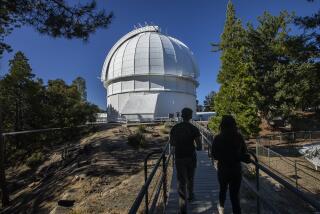William Fowler; Shared Nobel for Stars Study
- Share via
William A. Fowler, who shared the 1983 Nobel Prize in physics for his research into stars, died Tuesday in Pasadena. He was 83.
Fowler split the coveted prize with Subrahmanyan Chandrasekhar, a professor at the University of Chicago who also studied stars.
During his career, Fowler greatly contributed to the understanding of nucleosynthesis, the formation of chemical elements from simpler basic units.
The study of nucleosynthesis paralleled Fowler’s career, and he was usually considered its guru.
In the 1920s, physicists addressed the question of what mechanism drives the sun. By the late 1930s, researchers had determined that the fire at the center of the solar furnace is thermonuclear fusion, in which elements are fused, and in the process release enormous quantities of energy. Some believed that the fusion process depended upon the heavier elements of carbon, nitrogen and oxygen.
But Fowler led a counter group, discovering that the sun is ignited by the fusion of lighter elements--such as hydrogen and helium. He helped to show that the fusion of helium-3 ions accounts for the largest part of the sun’s energy output. In the late 1950s, he identified the importance of still another pathway--that involving a beryllium-7 nucleus with a proton.
Fowler also looked at other kinds of stars besides the sun--bigger, hotter, shorter-lived and more violent objects--and calculated what elements ought to be cooked in those stellar pots.
By determining what those reaction rates should be, he shed light on how different elements are produced by stars and in what relative abundances.
He determined that it is these elements, eventually scattered throughout the cosmos when the manufacturing stars explode, that are incorporated into newer stars (like the sun), planets and living things.
Fowler co-authored an article on nucleosynthesis for the 1957 Review of Modern Physics that became the classic reference for that subject.
He considered his Nobel an award for the work of many researchers, and when asked at a Caltech celebration party if the prize would prompt different treatment, he quipped: “Being a fellow who’s been called Willy for many, many years, I can’t see that there would be any change.”
His research was divided into theoretical studies to calculate fusion rates for a wide variety of elements, and experiments with accelerators to guide the theoretical calculations.
Fowler spent most of his life at Caltech. He earned his bachelor’s degree from Ohio State University but obtained his graduate degrees at Caltech and then joined the prestigious institute’s research team and eventually its faculty.
In 1970, he became Caltech’s first institute professor, an honorary designation granted only to the most distinguished faculty members. He retired from full-time teaching about a year before he earned the Nobel, but continued to do research.
Among his many honors, Fowler received the National Medal of Science from President Gerald Ford in 1974, and the Legion d’Honneur from President Francois Mitterrand of France in 1989.
The physicist is survived by his second wife, Mary Dutcher Fowler, and his daughters, Mary Galowin and Martha Schoenemann.






